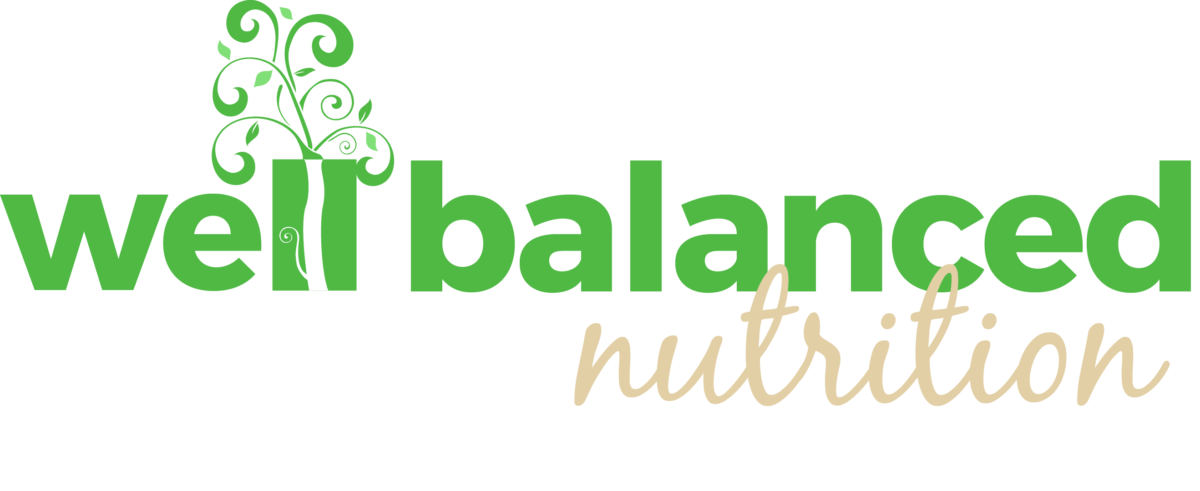
by Lucy | Nov 12, 2017 | Well Balanced Wisdom
Food cravings are tricky. Have you noticed that some just can’t be ignored? You know, when you crave something specific like a brownie, and you try to satisfy the craving with something else that’s a little healthier, let’s say yogurt or a granola bar because you are working so hard to stick to your goals. But then you still can’t stop thinking about that brownie. You might try several things to appease the desire, but nothing seems to work. Your craving remains and you finally give in. In those cases, it’s just best to have that brownie in the first place instead of having several alternatives, only to eventually indulge in the brownie anyway. You end up eating more unnecessary calories when you try to ignore an intense craving like that.
But what about those less intense cravings?
Like those silly cookies in the breakroom that are only a distraction but look so tempting. If we gave into ALL our cravings ALL the time, we could be setting ourselves up for excessive weight gain or unbalanced eating, especially over the holiday season. Here is a technique called the CRAVE WAVE that can help you manage your urges.
Go through this exercise first and then decide if your craving needs to be satisfied or you can let it ride.
- Acknowledge and name the craving: “Oooh chocolate…I definitely want that chocolate cake right now.”
- Visualize yourself riding the crave wave: Instead of letting the waves of the craving crash down on you and suck you in, picture yourself jumping on your surfboard, riding out the wave and safely coming back to shore. It might sound cheesy, but this imagery is a powerful thing.
- Refocus your attention: Walk away from the food, busy your hands, write down your current thoughts, slowly take five deep breaths or any other activity that can redirect your attention. Congrats. You just rode the crave wave!
If you need some more guidance on dealing with your cravings, let us know!

by Lucy | Nov 2, 2017 | Transformation Tuesday
I joined Well Balanced Nutrition because I had gained weight and my clothes were not fitting. I wanted to lose weight and get back to my weight from a year ago. I am a very self-conscious person and always compared my body to other people and was not happy with who I was.
I started doing one-on-one appointments with Lucy and she is amazing. Lucy listens to you and the goals you want to accomplish and helps you get on track. She explained to me how the well-balanced plate works and helped me eat more healthy foods, while still enjoying the foods I love.
I have a dog and he loves to go on walks and I always found an excuse to not be able to go on walks and Lucy told me about the 5-4-3-2-1 (The 5-second rule). Since implementing the 5-Second Rule, I take my dog on walks – he loves it – and it keeps me active and moving as well.
It has been an amazing journey for me, I have made progress since meeting Lucy. I eat more vegetables too. Before, I didn’t eat many vegetables and wasn’t up for trying new things either. Now, I portion my food and I am trying new things, such as recipes from Skinny Taste Cookbook. I am still a picky eater but much less than before. I go on walks with my dog and I have joined the gym and go 3 days per week, which that is a big milestone for me.
I have also learned to love myself and my body more. I’ve stopped comparing my body to others. We are all different, we do not know what other people are doing to maintain how they look or how long it has taken them.
We each have a different journey we embark on to get where we want to be.
For me, I found that I want to be and feel comfortable with the clothes I wear. Compared to where I was a year ago, I feel comfortable where I am right now, I feel confident. Also, I found something that I like to do which is donate blood and platelets and you must maintain a certain weight to donate.
Thanks to Lucy, I have been able to stay on track and know what to do if I get sidetracked from my goals. She has been amazing in helping me find what works for me and what doesn’t. She also helps me figure out what to change when I feel stuck and want to give up. I have learned how to eat the things I love while still maintaining a well-balanced style. For me keeping a routine works best and helps me stay on track with my weight. Well-Balanced Nutrition is just the best.
Let us know how we can help get you unstuck! Click here to get started today.
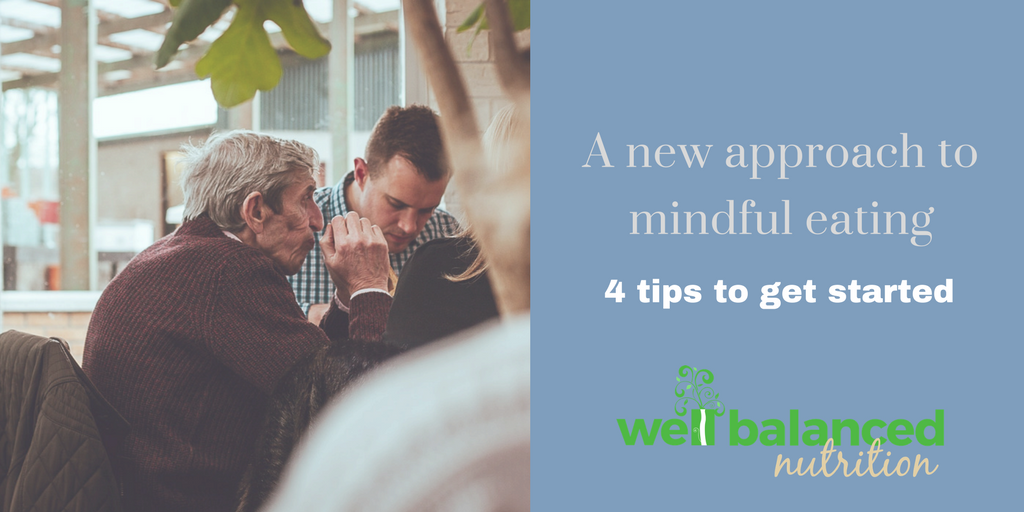
by Lucy | Oct 25, 2017 | Motivational Mondays
You know that empty feeling after you eat? The times you think, “that was so unsatisfying.” What if there is a different way to get the most nutrition and enjoyment from your food.
A client, who we will call Eric, was recently diagnosed with melanoma stage III. Eric is a young and otherwise healthy guy who typically eats a plant-based diet. He admitted to regularly eating a bowl of sugary cereal and milk at the end of the day for many years but with the diagnosis he a made the decision to cut out those foods. Eric is especially sensitive to sugar and has become choosier about what sweets he will eat. In the beginning, after the diagnosis, Eric was very fearful of food. He questioned what foods prevent a recurrence of cancer and what he should avoid.
It’s not what you’re eating, it’s how you’re eating it
Eric told me he was visiting a retired gentleman who offered him a Hershey kiss. Eric politely accepted this treat with the intention of getting rid of it later, at which point the gentleman said, “while you’re having one, I’ll eat one too.” In order not to offend his friend, he decided to join him in eating the chocolate.
I asked Eric what he’s learned since easing up on his sugar and carbohydrate restriction over the past two months. Eric thought for a moment and said he realized he needs to put less emphasis on what he is eating and more emphasis on how he is eating. This literally stopped me in my tracks. In a previous conversation, I had briefly mentioned mindful eating to Eric, but didn’t go into much detail. That’s why I was so impressed at how he came to this decision. Eric noticed after eating a meal while being distracted with computer work or in a meeting it did not feel as nourishing as those he savored and enjoyed more mindfully. For him, that means taking time to eat without distractions. Slowing down to savor the look, taste, smell, and textures of the foods.
The food and cancer conversation is highly controversial and there is a lot of conflicting science-based evidence out there. At Well-balanced Nutrition, we encourage people to embrace natural food, such as those items that are clearly coming from the farm, orchard or mother nature. I still have not come across an Oreo bush or pizza tree. When reading a food label, I don’t often look at the numbers. I want to know the ingredients. What is in the food?
Eric recognizes when he eats more slowly and enjoys the meal mindfully it feels more satisfying and enjoyable. He decided to take this a step further and plan for future meals. For instance, when thinking about Thanksgiving, he plans to take more time during that meal to savor the smell, taste, and appearance of the special holiday dishes. He plans on taking regular breaks throughout the meal – putting the fork down and enjoy the moment.
Here are 4 ways to start practicing
- Spend time considering the foods that are #WorthIt beforehand to make a mindful decision each time you eat
- Before shared meals and holidays imagine the event and sitting at the table
- Spend time savoring the meal (the look, taste, textures, smell, etc.)
- Stop during the meal – perhaps consciously putting the fork down in between bites – to slow the pace of how you eat
Food for thought:
We know making healthy food choices is important for reaching our health and wellness goals. When I’m being mindful and tuning in with what I really need, I tend to avoid the less nourishing options because I know they won’t make me feel better. How can you include a mindful technique to get more from your meals?
Let us know how we can help you on the journey! Contact us to get started today.


by Lucy | Oct 22, 2017 | Well Balanced Wisdom
What stresses you out? Is it traffic? Your to-do list that seems to be never-ending? Your kid’s messy room?
Your project deadlines at work? Money concerns? Whatever it is, the American Heart Association has a brilliant tool for letting go of your stress.
The scream booth is a stress reliever tool that first made an appearance on the streets of Austin, Texas and is now in the exhibition hall of the 100th Food and Nutrition Conference and Expo (FNCE) in Chicago, IL. The video below was posted on the American Heart Association – Austin facebook page and gives you a preview of what it’s like inside. Once you press start the screen asks you what stresses you out. It hears what you say, and the words appear on the screen. The words will only go away once you scream. Take it from me, it was very therapeutic – and at the time I didn’t have any real stress.
Excessive stress can contribute to hypertension, irritable bowel syndrome, and more. This activity reminds us all that we need to work out our frustrations in a harmless way, so the weight of our stress does not start to impact our health and well-being negatively. When you don’t have a scream booth out your backyard, what are you to do? Here are some other healthy ways of coping with stress.
- Screaming into a pillow
- Taking a nature walk
- Attending your favorite group exercise class
- Talking with a trusted friend or family member
- Journaling
- Coloring or creating art
- Meditation or deep breathing exercises
What are your favorite ways to cope with stress?

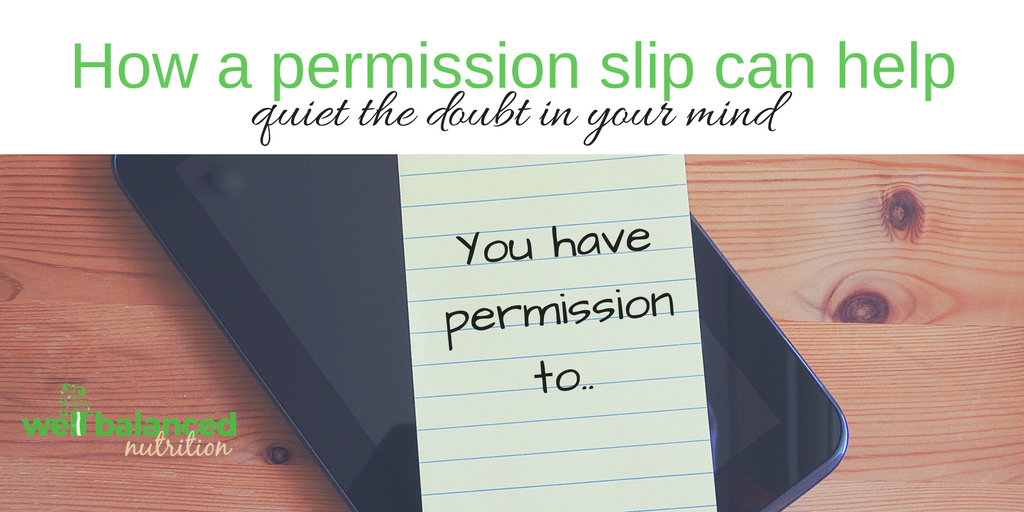
by Lucy | Oct 15, 2017 | Uncategorized
Imagine getting a call and learning that you have the opportunity to sit down with Oprah for an interview. Would you be nervous and awestruck? Would you try to play it cool? When Brene Brown, author and researcher, had this very experience she went through all those emotions. Before she went on the show, she found a pen and a post-it note, then jotted down a permission slip for herself that allowed her to be present in the moment, to enjoy it no matter how uncool she might look when she got excited and giddy. Brene apparently uses this technique often. I think it’s brilliant!
The other weekend I had an opportunity to either spend time with my family just relaxing, or get caught up on laundry and all the other chores. I felt the pull to get things on the to-do list checked off as usual, but I also knew the importance of unwinding with my family on a Sunday. Inspired by Brene’s written permission slip method, I got out a scrap piece of paper. On it, I wrote, “You have permission to relax and enjoy the day. Your to-do list can wait.”
That was powerful. The act of writing it down helped me let go of the ambivalence I was experiencing in my head. I went on to enjoy my Sunday as I should… relaxing with my family.
FOOD FOR THOUGHT:
Lucy and I give you permission to take good care of yourselves or to keep it simple, but sometimes only you will know what you need. So for what can you write yourself a permission slip? To enjoy a food you’ve been craving without guilt? To politely pass on a social opportunity that would make you fall off your current eating plan? Or maybe it’s permission to rest because your body is begging for a day off from your workouts.
Permission slips aren’t excuses; they are a way of silencing that inner critic who is always telling you that you aren’t enough and they are great for those moments when feel a battle going on inside your head. Permission slips help you honor your needs, be your own best friend, and solve the doubts in your mind.

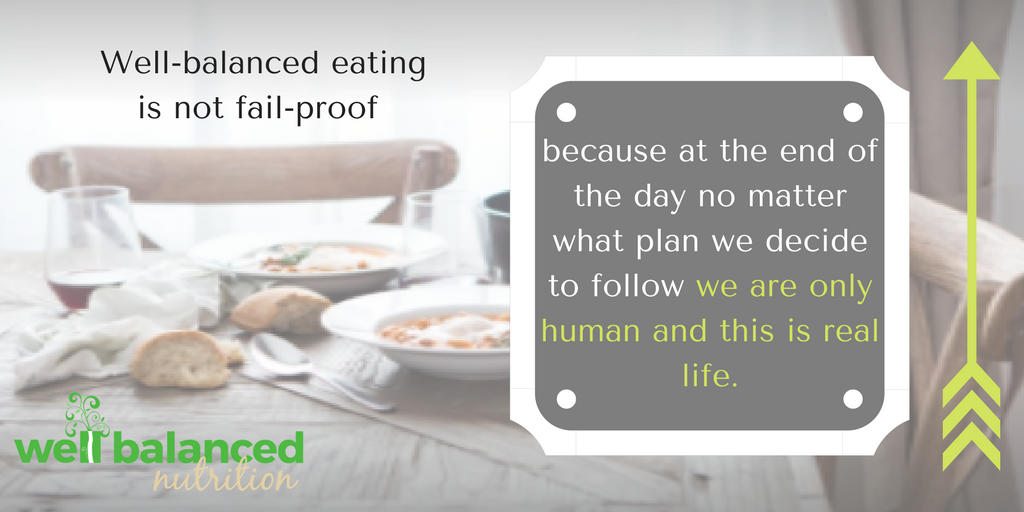
by Lucy | Sep 18, 2017 | Motivational Mondays
Monday, Sept 18, 2017
I just don’t do this often but I’m putting my foot down. There will be no more self-afflicted food shaming.
As Kristen eloquently states in her blog post, Why Well-Balanced Eating is NOT fail proof,
“Well-balanced eating (and well-balanced living for that matter) is not fail-proof because at the end of the day no matter what plan we decide to follow we are only human and this is real life.
Too often we expect the journey to be picture perfect and we don’t plan for the struggles. It doesn’t matter the number of mistakes, slips, failures – no matter what you call them – that you have, it’s how you embrace them and what you do next that matters the most. Lucy and I like to call them LESSONS because there is always something you can learn or a way you can grow from something not going the way you hoped. We can get a lot further if we embrace the struggle, have compassion for ourselves and never let our setbacks define us.”
Here to help (not judge)
Last week, I got to see a client who decided to enjoy free queso day at Moe’s Southwest Grill. She returned to her office just before our meeting and promptly said, “don’t judge me!”
I want to let everyone know, Kristen and I are not judging you. In fact, our goal is to support and encourage you, which we could not do if we were busy judging the people we want to help. Eat the queso! Just try do it mindfully.
On other occasions, people say “I shouldn’t have eaten…” which is personal food shaming for the decision made in the moment. We know from the article on, HALT that people tend to make the least healthy decisions when they are hungry, angry/frustrated, lonely, tired, or sometimes bored. If that’s the case, doesn’t it make sense to set ourselves up for success? Instead of spending time and energy thinking about what I “shouldn’t have done,” it will serve us better to learn the lesson and think about how to set up for success in the future.
For example, if I find myself eating the free food in the breakroom all morning because I didn’t eat breakfast, now I know I need to prioritize finding quick, convenient, and well-balanced breakfast options. Or if you notice you feel bad each time you eat out for lunch, it’s time to focus on bringing homemade meals to eat at lunch.
Food for thought:
Eating is supposed to feel good! Not only is it yummy, there is also a dopamine release creating a pleasurable experience to encourage us to keep eating regular meals and snacks. When eating is combined with shame, instead of feeling good we feel terrible.
This week take a moment to notice that little voice that says “shouldn’t.” How can you rephrase that into what you want or what will feel good? What lessons have you learned to help you make better choices?

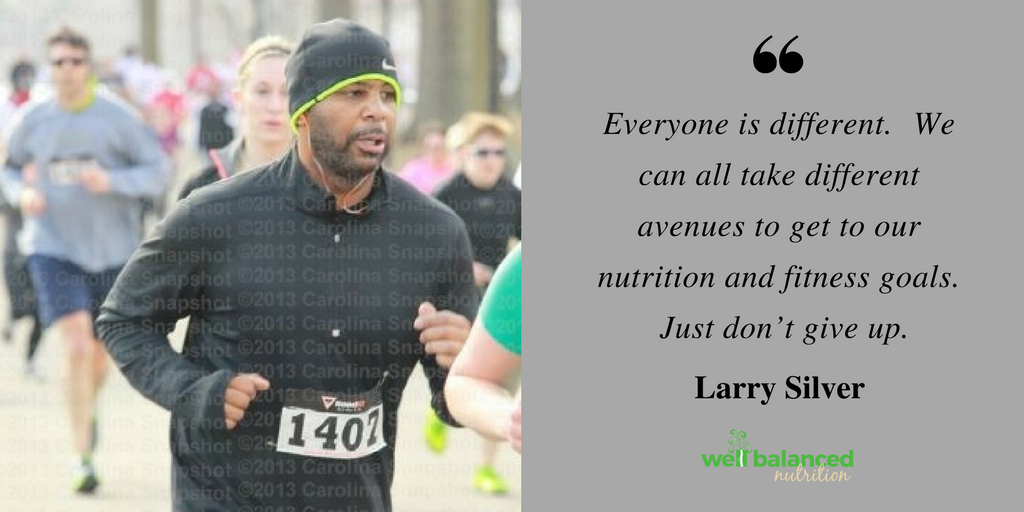
by Lucy | Sep 12, 2017 | Transformation Tuesday
Tuesday, Sept 12, 2017
Larry is one of those guys that you instantly like and want to hang out with. When I had the pleasure of meeting Larry in June, he told me about how hard he tries to eat properly and the steps he had already taken for his health.
When he first started to focus on his health, Larry joined a gym, included more activity such as training for local races, and started tracking his food with an app on his phone. His efforts paid off, and he reached a healthy BMI.
While in grad school, Larry picked up a habit of studying at Starbucks with a hot cocoa and peanut butter cookie (and stopped a few of his healthy habits). Within a year, he had regained nearly 30 lbs and knew it was time to get back in action.
Luckily, he finds listening to music and exercise to be a great stress reliever. It was easy for him to get back into exercising more often. He also decided to set healthy boundaries around his social time, and now his friends know not to offer him unhealthy foods on school nights.
I asked Larry to share his story. Below you will find some words of encouragement and how he uses the HALT method – including a mindful pause to ask if he is hungry, angry/frustrated, lonely, or tried – to stay on track.
What brought you to Well-Balanced Nutrition?
“I started working with Well-balanced Nutrition because I felt my eating habits were hindering my fitness goals. Although I’m fairly active and try to eat healthy (most of the time), I wasn’t seeing much carry-over on the scale.
I knew I was on track when I became more mindful regarding my eating habits. Using the HALT method has really made me think about nutrition in a way that not only makes sense to me but makes me think about why I am eating in addition to what I’m eating.
I’m still human and learned when I get off track, and I try not to “beat myself up too badly.” When I am hanging out with friends and family, it’s not unusual for food to be around and sometimes I’ll overindulge. I’ve tried to realize there is an ebb and flow on this fitness journey, so I try and get back on track.
Best strategy I’ve learned
The best strategy, tool, tip, or technique I’ve learned on my well-balanced journey is the HALT method. Thinking about nutrition using the HALT method makes me connect my mood/feeling with what I’m consuming. Many times, it’s made me redirect my food intake to doing something like walking the dog or taking a bike ride.
Everyone is different. We can all take different avenues to get to our nutrition and fitness goals. Just don’t give up.”
Are you ready to make a transformation like Larry? Contact us today to set up your own personal wellness adventure. It may be the path you’ve been looking for!

by Lucy | Sep 8, 2017 | Recipes and Meal Ideas
Want a fun way to fill half your plate with vegetables? Look no further! Spaghetti squash appears boring on the outside, but on the inside resembles thin spaghetti noodles once cooked. It’s slightly crunchy and very mild in flavor making it perfect for sauces, seasonings, and add-ins. This recipe brought to you by our lovely intern, Wendy, is an excellent example of how it can be jazzed up with your favorite flavors.
Spaghetti squash is in season now. It contains 40 calories and 7 grams of carbohydrate in each cup. So go ahead, enjoy nature’s noodle! If you have never cooked spaghetti squash before you might find these tips for preparing it helpful.
- 3 chicken breasts cooked and shredded
- 1 cup low-fat buttermilk
- 1 cup buffalo wing sauce
- ½ cup finely diced carrot
- ¼ cup finely diced celery
- ¼ cup finely diced red onion
- 2 cloves minced garlic
- 1 cup shredded low-fat mozzarella
- ½ cup blue cheese crumbles
- 1 large spaghetti squash
- 2 tablespoons olive oil
TO PREPARE SPAGHETTI SQUASH:
Preheat oven to 350 degrees.
With a sharp knife carefully poke a few small slits in the squash skin; poke in a dotted line along where you plan to slice the squash in half. Then microwave squash 4 minutes and let cool slightly.
Cut the spaghetti squash in half, scrape out the seeds, and place on a baking sheet cut side down. Roast for 45 minutes. Set aside to cool.
Increase oven temperature to 425 degrees
When cool enough to hold, scrape the squash out of the skin into a large bowl.
TO PREPARE THE BUFFALO SAUCE
Mince the garlic
Finely dice the carrot, celery, and onion
Heat olive oil in a pan and sauté the vegetables and garlic for about 5 minutes, until they become soft.
Stir in the cooked chicken, buttermilk, and buffalo sauce. Stir to combine. Turn the heat down to low.
Stir in ½ cup of the mozzarella cheese and mix to combine.
FINISH UP BY MIXING THE TWO:
Combine chicken and vegetable mixture with cooked spaghetti squash in a 9x13 baking dish. Top with the remaining mozzarella and blue cheese
Bake, covered with foil, for about 25 minutes.
Remove the foil and continue baking for another 15 minutes, until the entire dish is slightly bubbly and the cheese is starting to brown.
Let cool before serving.
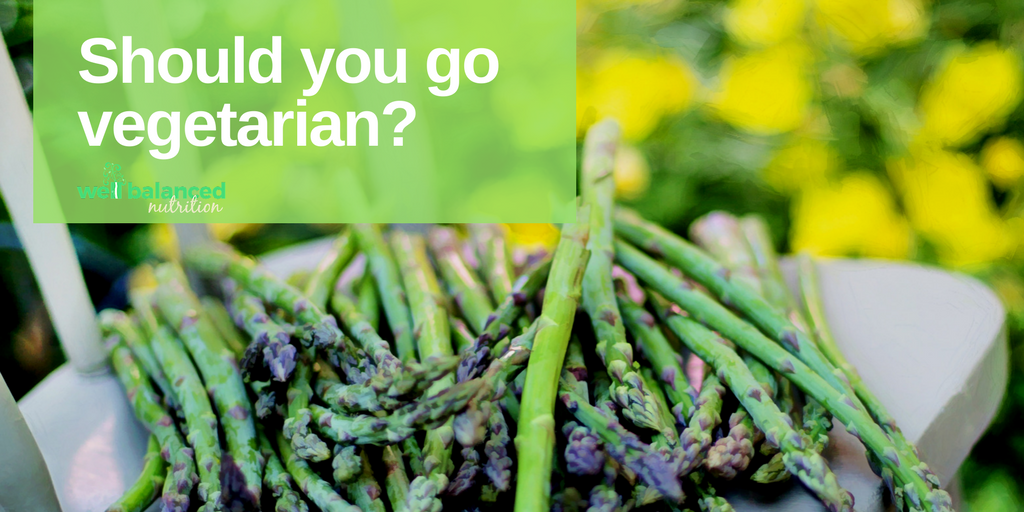
by Lucy | Sep 6, 2017 | Well Balanced Wisdom
That’s a fantastic question. If you feel compelled to go vegetarian, it likely means that you care about your health. We love that about you! You also may realize that eating more plants can help you live longer and fight off disease.
We think it’s awesome that you want to eat healthier and that you want to eat more plants! If a healthy lifestyle is what you are going for, we want to help you do it in a way that serves you best. Cutting out meat and becoming a vegetarian is one way to start eating better, but it’s only part of the picture and not the only way to get healthier. You don’t have to become a total vegetarian to reap the benefits of a plant-centric lifestyle. Below are some suggested steps that can be just as good, if not better in some cases, than going completely vegetarian.
Buy less processed foods and more foods in their natural state. Replacing meat with processed foods of different kinds doesn’t make your diet all that healthier. Oreos, white bread, and Twinkies are all vegetarian but not so nutritious. Just saying. =)
Focus on smaller quantities of higher quality, ethically-raised meats and/or vow to choose more fresh turkey and chicken over sausage, bacon, lunch meats and cured red meat. If the idea of eating more turkey or chicken sounds boring, then perhaps you would benefit from learning to use more fresh or dried herbs to spice up your chicken and turkey dishes. You could even try a cuisine that is new to you. Another way to shake things up is to include more seafood in your routine. Fish is a healthy option a couple of times a week. (EWG’s guide to seafood can be helpful if you are curious about safe and sustainable seafood.)
Implement a few meatless days of the week. To do this well, it may mean you need to experiment with more plant-based sources of protein like lentils, peas, chickpeas, soybeans, hemp seeds or chia seeds. Notice I didn’t say soy burgers. While those are a nice option on occasion, they tend to be highly processed and are less natural than the above choices.
Expand your plant palate. When you eliminate meat, you’ll need to find other sources of protein, and you will still need to fill half your plate with non-starchy vegetables. If plant-foods are limited in your diet now, your goal should be to try new vegetables, fruits, seeds, or legumes. Another idea is to try new methods of preparing ones you already eat. There are over 60 plant foods in-season over the summer months and 55 different plant foods that will be in season come the fall. If you can count the number of plants you eat on your hands, it’s time to expand!
Food for thought:
We encourage you not to focus so much on what you must take out (like meat) and focus more time and effort on what you can add to your plate (more yummy vegetables).
Ready to go vegetarian? If you are ready to follow a vegetarian meal plan, we are here to help! It is possible, and it takes some effort to get the right amount of protein, vegetables, and starches only from plants. We want you to remain balanced!
Is going completely vegetarian not right for you? That’s okay too! You can still eat a plant-centric diet by taking some of the above steps. Plus, we can help!
Start working with us today.
Tell us in the comments below:
What steps will you take or are you taking now?
Do you follow a vegetarian lifestyle? Tell us your favorite tips or tricks!

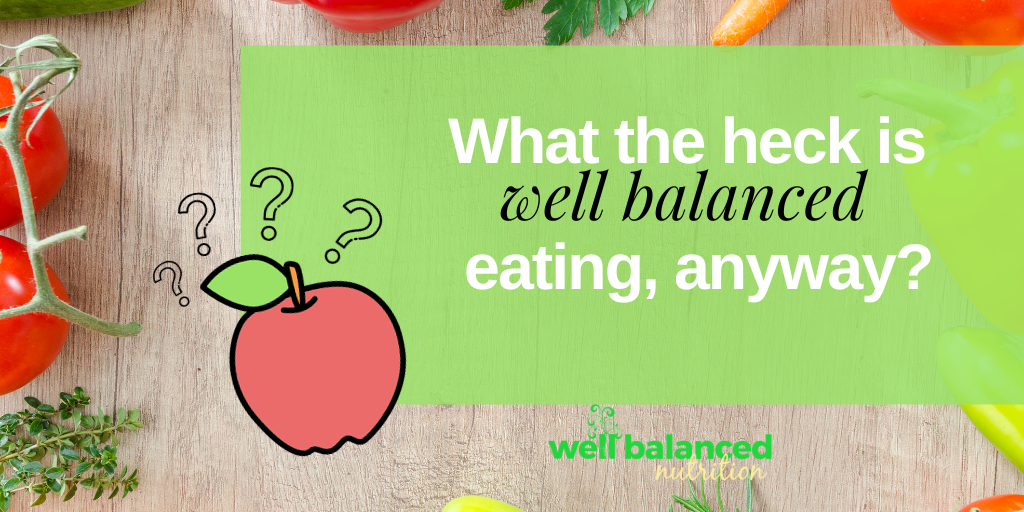
by Lucy | Sep 3, 2017 | Well Balanced Wisdom
Kristen and I talk a lot about eating well-balanced, but unless you have sat down with us or heard the Well-Balanced Plate talk you may be wondering… what does that mean?
The Well Balanced Plate
After reading countless research articles, books such as The Blue Zone Solutions, and a combining over 20 years of professional nutrition experience, Kristen and I recognize the benefits of a mostly plant-based diet incorporating protein, complex carbohydrates, and healthy fat. Eating them in the proportions shown on the Well Balanced Plate helps you feel full and satisfied, not deprived and ridden with cravings. When we eat foods from nature in this way, we can start to trust and rely on our body and mind to remind us what, how much and when to eat.
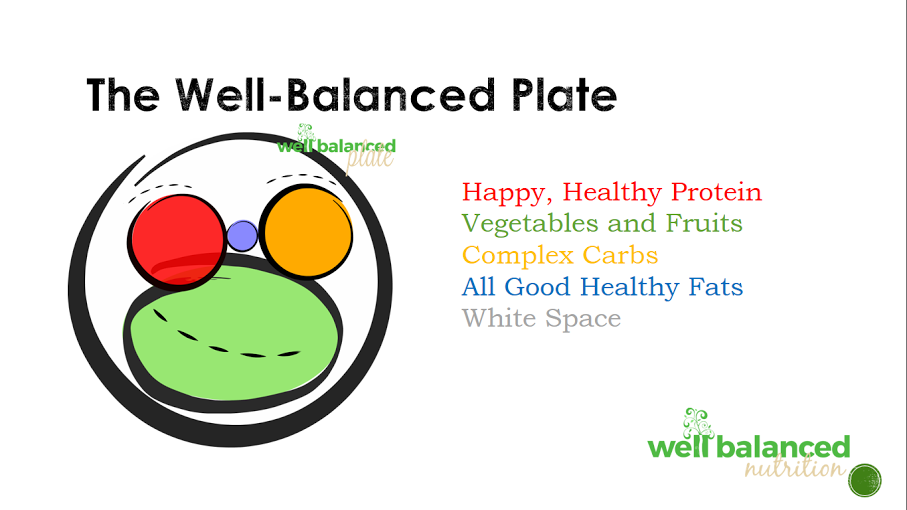
The Well-Balanced Plate was created to visually represent a balanced meal or snack.
Mostly fruits and vegetables
Five populations in the world have the highest concentration of centenarians, people living over 100-years, and they all have something in common: a plant-centric diet. You can read all about their lifestyles in the Blue Zones. Many people who’ve read the book assume you have to be a vegetarian to live a long, vibrant life. In actuality, four of the five communities eat animal protein on a regular basis; however, they make meat more of a side-dish rather than the main course.
You’ll notice that the largest section of the Well-Balanced plate is for vegetables and fruit, not meat or carbs. By filling half of your plate with non-starchy vegetables and fruit, you will not only fill up on fewer calories, but also (and most importantly) get the health benefits of vitamins, minerals, fiber, and phytochemicals.
Vary your Veggies
Kristen wrote more about the benefits of fruits and vegetables in an earlier post and encouraged eating a variety. America is a melting pot of ethnic cultures which means we have many food options at our fingertips. Eating healthfully doesn’t have to be boring. Change things up and try a new vegetable or a different way of cooking, such as implementing Meatless Monday or trying an ethnic dish.
It’s not perfect. It’s flexible and enjoyable.
Well-balanced eating is not perfect. First of all, there will always be celebrations, cookouts, holiday parties, etc. when healthy choices are limited, and in those cases, we make the best decisions at that moment. Secondly, food is enjoyable, and it’s okay to indulge when you decide it’s worth it. Ellyn Satter, an internationally recognized dietitian and feeding therapist, sums it up well when she says, “normal eating is being able to give some thought to your food selection, so you get nutritious food, but not being so wary and restrictive that you miss out on enjoyable food.”
It’s more mindful and less impulsive.
Mindful eating strategies can help us become normal eaters and avoid the point when cravings, emotional eating, and daily life can consistently lead to unhealthy choices that leave our bodies fed but undernourished. Lucy shared HALT, an acronym to explain why our poorest choices tend to happen when we are hungry, angry/frustrated, lonely or tired, and Kristen shared how gathering some DATA can help you cut back on sugar. Another mindful concept is what we call “20% white space“, where we purposefully give ourselves time to check in with our bodies to determine if we are still hungry.
It get’s easier with time
Every time you eat is an opportunity to practice being well-balanced. Eventually, you will no longer have to try so hard because you have practiced for so long.
It means ditching the diet and striving for self-care.
The media keeps reminding us that two out of three American adults are considered overweight or obese, and there’s this pressure to be thin like the women we see in magazines. This messaging, along with the fad diet industry, is creating a culture full of body shame and food guilt. That feels demoralizing.
Many people come to Well-balanced Nutrition with a goal to lose weight. We know that diets don’t really work. Instead of focusing solely on the food, we help people identify the behaviors and patterns that prevent them from reaching a healthy balance. We talk about making small behavior changes to create a compound effect which will result in more energy, confidence, and yes, typically a lower number on the scale. We use weight as a tool, but with the understanding that weight is only a small part of your health picture. Ultimately, we want our WBN tribe to eat well because it feels good and allows them to live a full life not just for that number on the scale.
A way of life
Well-Balanced Nutrition is more than a plate; it’s a way of life. If you have sat down with Kristen or Lucy, you know we talk about much more than what you eat. We ask about who buys and prepares the food, what your typical day looks like, how much sleep you get, your stress level and so on. We even take note of your personality, attitudes, and beliefs. We consider all these things when we work with you to create a well-balanced plan. Each of us comes to the table with a different story, but we all have a desire to be our best selves.
To sum it all up, well-balanced eating means ditching the diet mentality where foods are either good or bad, clean or dirty. Restriction, shame, and guilt should not be the norm. Instead, shift your focus to eating more natural foods and tuning into your body and mind. Eat mostly plants and do something every day that makes you feel good and can help you live your best life.
Ready to start eating well-balanced? “Lettuce” help! 😉

